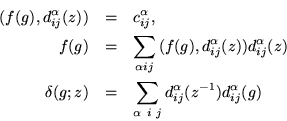
The basis relations for group functions can be rearranged by taking traces of the matrix elements, and noticing that traces are invariant under change of basis. On the one hand, traces are invariants of equivalences so the result will not depend on changing to an equivalenmt representation. On the other, the same is true for internal equivalences of the group, making traces functions of classes, not merely of individual group elements. The trace is a function for which the classes are equivalence classes.
The trace-valued group function is called a charactercharacter for its representation, defined by



There is now a new function space, mapping classes to complex numbers, for which the characters of the irreducible representations form a biorthonormal set, which would mean that the number of inequivalent irreducible representations cannot exceed the number of classes.
As remarked, characters are not only insensitive to equivalences arising within the group, but to external influences as well. That all equivalent representations have the same character allows their characterization, which was undoubtedly the origin of the term. Beyond that, if a representation is reducible, the biorthonormality of characters permits finding out which irreducible representations are in the blocks. For a representation
![]() ,
,

At the same time, because the regular representation contains an equivalent of any irreducible representation at all, their characters have to be present among the complex valued class functions. The only obstacle to knowing that the number of irreducible representations is equal to the number of classes would be to show that the characteristic function of a class was a linear combination of characters. Pretty much by definition, the reverse is true, characters are linear combinations of characteristic functions of classes.
We already know that the characteristic functions of points are linear combinations of matrix elements; if

Next, consider that a class arises from finding conjugates from within the group: elements for which ![]() for all
for all ![]() . So sums over a class just average these conjugacies:
. So sums over a class just average these conjugacies:
![]() . Representationwise here is a matrix commuting with an irreducible representation, so
. Representationwise here is a matrix commuting with an irreducible representation, so
